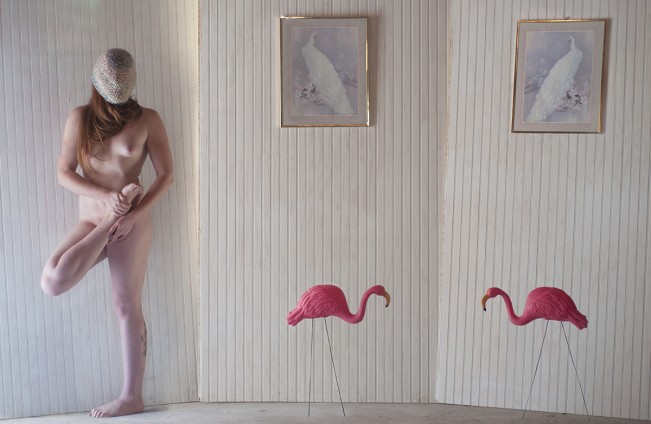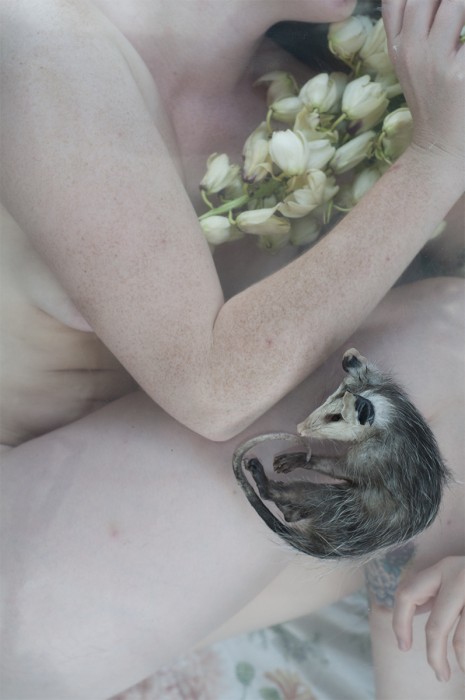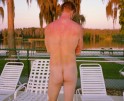Kristen Roles: The States Project: Florida
Today it is my pleasure to share the work of Kristen Roles. When I was first shown Kristen’s photographs by a former professor, I was immediately struck by the expressive and delightfully bizarre nature of her work.
Kristen is a photographer working in narrative self-portraiture, but I would also consider her part performance artist and sculptor. In many of her photographs, she shares the frame with symbols of Floridian culture while interacting with them in ways that often imply a physically straining and uncomfortable relationship with her surroundings. Utilizing personalized “candy-colored” interior spaces as her stages and her body as a narrative prop, Kristen constructs photographs that metaphorically explore her psyche and daily experiences.
Kristen Roles is living, working, and generally making messes in Tampa, FL, where she earned a BFA and a BA in psychology from the University of South Florida in 2014. She is currently in the process of moving to Albuquerque to pursue an MFA at the University of New Mexico beginning this fall.
Trifling Admissions
“The illusion of knowing has blinded us to the fantastic pain and pleasure of acknowledging that we may know nothing after all.” – Amelia Jones
We are living in a liminal moment. There is a growing outcry for change and justice and human equality in this progressive but restless social and political climate, and yet I am a member of a notoriously complacent American Millennial generation. We are on the tipping point of a call to action, but we are branded by self-consciousness, “selfies,” and idleness. With much anxiety, I entertain this contradiction. Instead of taking any truly activist stance, I mull around making pictures. But it is from this act of fabricating photographs that I can garner a sense of purpose and attempt to situate my existence in the midst of the larger and more consequential conversations deserving of attention in the world around me.
In Trifling Admissions, I make and photograph assembled environments and the uncomfortable momentary experiences of a figure within them. In using my own body as subject, I unavoidably absorb the possibility of falling into art-historically traditional implications of the female nude. Nakedness (rather than nudity) functions for me as a way to seize authorship of the self-perceived awkwardness of my body as it exists in space. Actively contorting myself in the frame behooves that awkwardness while serving as a little feat of transgression, a way to subvert any invitation of the theoretical construct of “the gaze.” My body is an aggressor (albeit sometimes a clumsy or quiet one) on the scene rather than deferring as a passive part of the landscape. It is to be confronted rather than just contemplated.
Quotidian materials stand in for nagging preoccupations and neurotic ticks. They are superfluous but consuming, like the anxieties that tug on my consciousness and the materially-centered society of which I am a participant. Pink-painted sandbags and pastel gelatin molds are unassuming but concrete burdens. Interacting with the objects in displays of poor or unexpected etiquette within constructed, candy-colored domestic spaces, I elevate my subjective self-consciousness to connote objective self-awareness and a more general awareness of the fallibility of being human.
Jones, Amelia. 2002. “The Eternal Return”: Self-Portrait Photography as a Technology of Embodiment. Signs Volume 27 No. 4: 947-78. The University of Chicago Press.
How did you get turned on to photography?
I first started pointing a camera in any sort of considered way in high school and it has ever since felt like the most natural and honest tool for translating the things I see and absorb from the world into things I put back into it for display. My interest evolved, and is ever evolving, from self-expression and a romantic documentation of my personal world to a more mindful interrogation of the role of our medium in universally applicable discussions and the paradigm shifts (socio-cultural, technological, etc.) happening within our lifetimes.
Your work seems to draw on multiple art disciplines. Do you consider yourself in dialogue with other artists in particular who are working in a similar style? Do you have any notable influences? What informs your work?
Employing the body, particularly my own body, in defiance of convention is a primary source of motivation in my Trifling Admissions series, so I’ve definitely drawn inspiration from contemporary greats working in this vein through all mediums, like Hannah Wilke, Kiki Smith, Jenny Saville, and Pipilotti Rist. I admire Wilke’s grasp on the fundamental instability of her reiterated image and assertive denunciation of a unilateral gaze; the delicate fragility retained in Smith’s assertions of abjection, mortality, and feminism; the unapologetic presentation of flesh embraced by Saville; the poignant mischief embedded in Rist’s indulgent palette and sugary rudeness. Amelia Jones’s writings on the transgressive body and presenting the self as “other,” the familiar as foreign, helped situate the way I think about my own work.
Lately I’ve been really into photographers focusing on materiality (or inherent lack of, in the case of Instagram, my fascination with which I’ll rant a little more about later) and the recontextualization of found/existing images. Artists like Anouk Kruithof and Thomas Mailaender, who has explored the potential of the human body as a light sensitive material, are recent infatuations. Peers with whom I’m in a regular dialogue about these topics even though our work is stylistically very different, like Robert Dallas, are also a huge and constant influence.
I’ll also ask anyone reading this to please check out the work of Jaroslaw Studencki, who had the most profound and permanent impact on my sensibilities and life as a whole, and whose sensitivity to his subjects and the care he took in acknowledging and never exploiting the power that comes with wielding a camera was unparalleled. He left this world recently, but his remarkably intimate work, a reflection and extension of his character, should live on.
As your photographs are highly constructed and performance based, can you talk about your process and how you make decisions regarding your compositions? Do you typically have a narrative in mind before you create your stage or do things happen more organically?
I do a lot of dog/housesitting. For the earlier images in Trifling Admissions, the ones staged in more dimensional settings as opposed to the uniform white paneled walls of the latter half of the series (the ones most markedly defined in pastel pinks, purples, and blues), I would often come across a home or a particular room or floor or wall that begged to be photographed and mentally catalogue that location until it aligned with an idea or a title or a gesture I wanted to convey. So the shooting of a given composition that I’d have in mind was often timed around when I’d have access to the location. For the latter white-walled evolution, I wanted to rely less on existing spaces to define the aesthetic and feeling and instead build from the ground up, or rather the walls forward. This allowed me a consistent backdrop against which to add each element and keep the focus on the figure and deliberate props rather than on the environment. I think/hope that little shift helps to more cohesively nod to the overarching themes behind the work rather than the images coming across as individual narratives.
The posing of my body and how it acts on the space tends to be more organic, as I’ll usually set up the frame and the objects within it and then spend a good while with my remote trigger or a trusted shutter-releasing friend to figure out how my form can fit most dynamically and purposefully within the image.
In many of your photos, you use your body as a narrative prop. As your body is so central to your photographs, do you mind talking about how you utilize it and view it as an element in your work?
There’s definitely been a process of embracing my own awkwardness, fleshiness and presenting it as a vehicle for contravention, loaded equally with insecurities and the potential for authority. In progressing with this body of work I’ve grown very conscious of avoiding poses that project passivity but that retain a strong dose of vulnerability.
Some of these images seem like they were pretty painful to make, and I think there’s a tension in that pain. Is this something that matters to you or that you think about when making your pictures?
I’m glad that tension comes across because it’s that level of tenuousness, the discomfort of looking at my body and its inanimate extensions and hopefully projecting a measure of self-reflection, that makes a successful image to me. Physical strain or contortion is my version of The Return of The Gaze.
Also, a lot of the personal fulfillment I got out of this body of work was gleaned from the labor behind each image. Time spent with my body to make it act and interact as I wish it to in the frame is time spent in contemplative examination, as much about how I allocate my time, efforts, and worries as about my corporeality. I dwell a lot on the triviality of much of what we concern ourselves with in our daily routines and the relative pettiness of most of my anxieties, so these images are in part a reflection of the dissonance I’m yet unable to reconcile between the narcissism of my actual habits and inclinations and feeling the need to engage in some more humble and meaningful cause.
You incorporate a lot faux wood walls and pastel colors that remind me of so many Florida homes built in the early eighties. Did you grow up in Florida? (If so, do you think that upbringing has impacted your aesthetic?)
I was born in Rhode Island and consider myself a New Englander at heart (most of my family is there, and the environment just agrees with me more), but my mom and I moved here when I was eight, so the majority of my upbringing has been Florida-based, and I do regard the Sunshine State as home for the relationships I’ve built here and in the many ways this place has shaped my life and work. So yes, I’m sure my tendency to gravitate towards pastels and muted, pukey tropical colors is heavily informed by my surroundings!
I’m both intrigued and repelled by the idea of Florida as this land of escapism, the spring break and retirement destination of a very particular breed of tropical kitsch. Many of the earlier images from my main body were shot in the homes of retirees for whom I housesit and the occasional friend’s parents’ or grandparents’ 70’s/80’s Florida time-capsule homes. I’m actually sitting on the porch of one such home at this moment (today’s rain has made the FL summer heat more bearably balmy than stifling), swinging on a bench whose painted text and margarita glasses remind me that “it’s 5 o’clock somewhere” and facing a shelf full of colorful wooden sculptures of fish and a coffee mug shaped like a boob.
More than exclusively Floridian commodities filtering into my aesthetic, though, are I think references to the domestic as a whole as a representation of first-world comforts and material preoccupation. The objects and settings I choose tend to echo the mindset of suburbia, of ego- and ethnocentric views of the narrow, close-to-home, routine concerns of my generation and society and self. My uncomfortable interaction with them reflects my uncomfortable revulsion by but continued hypocritical use of these societal comforts, elucidating a lack of struggle and a presence of excess that breeds characteristic disengagement and complacency. I am complicit in these comforts and vanity. Larry Sultan similarly acknowledges indulgence in his work in regards to his Pictures from Home, describing his position as “a subject in the drama rather than a witness. And in the odd and jumbled process of working everything shifts; the boundaries blur, my distance slips, the arrogance and illusion of immunity falters (Sultan, 1992).”
What are you working on right now that you’re most excited about? Would you like to talk about a couple of your most recent photos?
I’ve been in a rut with making the constructed, tableau-type work I’ve focused on for the past few years. I have, though, been doing a whole lotta’ Instagramming the past handful of months and have slowly come to regard, against my initial and probably better judgment, the accumulation of the things I’m posting as actual “work.” I’m definitely indulging in the immediacy and accessibility and effortlessness of that forum and the apparent less critical importance of any single snapshot in the ubiquitous sea of images. I‘m most interested in the posts of users I follow who are subverting the self-promotional nature of the app (the most typical “look what cool thing I’m looking at, place where I am, thing I’m eating”) with either more intimate, abstract musings or glaringly vernacular shots that seem self-aware of their fleeting glamour enough to be granted some merit. While I grapple with the validity of these pictures existing solely in this intangible form, or whether that in itself is their value and to present them in some form beyond the screen would actually make them less artistically valid, I affirm that there is a discussion to be had (rather, one that’s already being had and that I might like to join) about the role of art image-democratizing media such as Instagram and its role in the shifting definitions of photography in the current technological climate. At the risk of being part of the problem, here’s a bit of my own Instagram gallery, which includes some real-time snapshots but more often consists of pictures taken with my iPhone of existing images on my laptop screen, ruminating on and representing pieces of my personal visual history and removing them one step further from their already digital origins.
I understand you’re headed to grad school in the fall at the University of New Mexico. Congratulations! What else is next for you? Do you have any upcoming projects or shows you’d like to plug?
Thanks!! Yes, I’m heading to Albuquerque (trading in one notoriously sunny landscape for another, I guess!) in the rapidly nearing future.
“What’s next” is kind of an anxiety-inducing prospect at the moment as I’m not entirely sure what form my work will take going forward! I hope to draw a good balance of inspiration from my new environment without getting too swept up in the magic that is the Western landscape. I do know that I’m ready to abandon self-portraiture (at least as I’ve thus far employed it in the traditional sense), as it’s come to feel troublingly egocentric at a time in my life where I’m deeply needing to step outside of myself and instead be more conscious of all that’s around me. I do, though, want to continue exploring such themes as the precariousness and fluidity of identity; discontentment with societal norms, banality, the commodified principles of “first-world” comfort under which I am privileged but ashamed to live; and the general fallibility of being human. I want to make images that are inviting to enter but uncomfortable to stay in, inciting the viewer walk a threshold between passive security and active vulnerability as I navigate that line myself.
With all the chaos of this cross-country move, the only upcoming show currently on my radar is At First Sight, a group exhibition introducing the work of UNM’s incoming grad class to the community. It will be running August 28-September 11 at UNM’s CFA Downtown Studio in Albuquerque. I am wildly excited about and receptive to the influence this new place will have on my perspective and practice!

©Kristen Roles, The Default Effect, 2014
Specimens
Posts on Lenscratch may not be reproduced without the permission of the Lenscratch staff and the photographer.
Recommended
-
Chris Otten: The States Project: FloridaAugust 23rd, 2015
-
Roy Albert Berry: The States Project: FloridaAugust 22nd, 2015
-
Katty Hoover: The States Project: FloridaAugust 21st, 2015
-
Kristen Roles: The States Project: FloridaAugust 20th, 2015
-
Annie Donovan: The States Project: FloridaAugust 19th, 2015
















































































